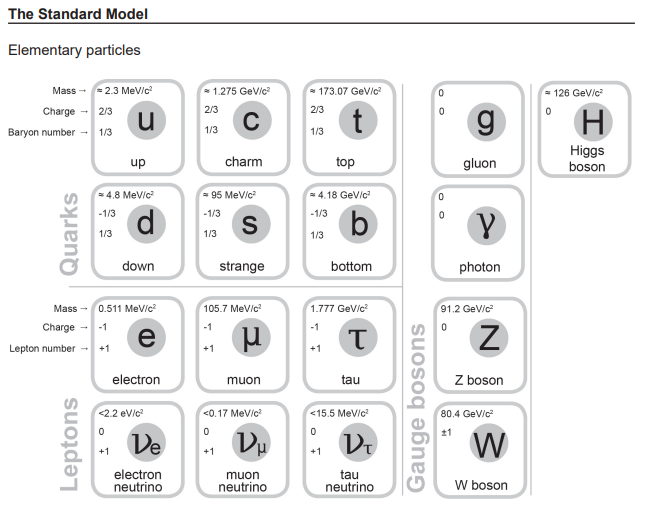Norrie recommends this website.

Mass displayed represents rest mass. Convert to Joules, then divide by $c^2$, resulting in a conventional mass.
Fermions: building blocks of matter. These are the 6 quarks and the 6 leptons
Gauge bosons: Exchange particles which mediate forces
Antimatter: all fermions have an anti-particle equivalent, i.e. opposite values. If a matter particle and anti-matter particle collide they annihilate, releasing energy.
Norrie also recommends hyperphysics!!!
These properties are important to memorise for test:
Top (Quark)
Bottom (Quark)
Tau (Lepton)
Tau neutrino (Lepton)
We notate antimatter, by putting a line on top of it, with the exception of an electron/position! For example, anti-up is $\bar{u}$, anti-charm is $\bar{c}$.
The antiparticle of an electron is a positron. But p is for proton. So:
$$\begin{align} \text{Electrons: } e^- \\ \text{Positrons: } e^+ \end{align} $$Quarks join together to produce hadrons, due to the strong force (mediated by gluons) holding them together.
Hadrons are thus any combination of quarks There are 2 common hadrons:
Please note that mesons are bosons, NOT fermions. This is because they have an interger spin, which fits the definition of a boson.
Examples of baryons are protons and neutrons (where have I seen this before)
| Quark | Charge |
|---|---|
| $u$ | $+\frac{2}{3}$ |
| $d$ | $-\frac{1}{3}$ |
Hence,
$$\begin{align} \text{Protons (+1): } uud\implies \frac{2}{3}+\frac{2}{3}+ -\frac{1}{3}=+1 \ \checkmark \\ \text{Neutron (0): } udd \implies \frac{2}{3}+ -\frac{1}{3} + - \frac{1}{3}=0 \ \checkmark \end{align} $$Photon - No mass - Electromagnetic force Gluons - No mass - Strong force W&Z bosons - Mass - Weak force Graviton2 (?????) - ??? - Gravity, if we could figure out if it exists...
Higgs boson - Mass - Mediates mass. Note that it has 0 spin. LHC - Massive particle - High energy The Higgs boson accounts for the mass in all other particles and solves a bunch of random issues.